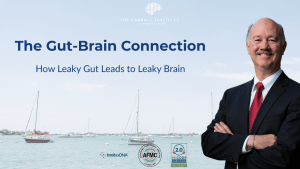Last Updated: October 2025
Heavy metals are all around us—found in air, water, food, and even dental fillings. While small amounts may seem harmless, years of exposure can quietly build up in the body, especially in the brain. Research continues to show that toxic metals such as mercury, lead, and aluminum can damage neurons, disrupt memory, and contribute to Alzheimer’s disease. At The Carroll Institute in Sarasota, Dr. Garland Glenn, DC, PhD, AFMC helps patients uncover hidden toxic burdens that contribute to cognitive decline using The Bredesen ReCODE Protocol and Functional Neurology.
How Heavy Metals Enter the Body
Heavy metals are common environmental contaminants. Mercury exposure can come from dental amalgam fillings, fish, and vaccines; lead may be present in old paint, water pipes, or soil; and aluminum often hides in cookware, cosmetics, and even certain medications. Over time, these metals accumulate in tissues—especially in the brain, where they disrupt communication between neurons.
Unfortunately, many of these exposures go unnoticed for years. Because the symptoms develop slowly—fatigue, memory issues, poor concentration—they’re often mistaken for “normal aging.”
Why Heavy Metals Are Toxic to the Brain
Heavy metals interfere with essential biochemical processes. They bind to enzymes and proteins, block nutrient absorption, and promote oxidative stress. When these metals cross the blood-brain barrier, they can directly harm neurons and glial cells—the brain’s support network. Studies published by the National Institutes of Health show that chronic heavy metal exposure can increase amyloid plaque buildup and accelerate neurodegeneration.
- Mercury: Damages mitochondrial function and disrupts neurotransmitters such as dopamine and serotonin.
- Lead: Impairs synaptic plasticity, reducing learning and memory formation.
- Aluminum: Promotes oxidative stress and is linked to increased amyloid deposition in Alzheimer’s disease.
- Arsenic and cadmium: Contribute to vascular inflammation and cognitive impairment.
Symptoms of Heavy Metal Toxicity
- Brain fog and slow mental processing
- Memory loss or difficulty focusing
- Chronic fatigue and headaches
- Peripheral neuropathy (tingling or numbness)
- Depression, irritability, or anxiety
- Digestive or immune dysfunction
Many patients experience these symptoms for years before learning that their environment—or even their dental history—was contributing to the problem.
Testing for Heavy Metal Toxicity
At The Carroll Institute, Dr. Glenn uses advanced testing methods to identify and measure heavy metal exposure, including:
- Urine or hair mineral analysis (to assess accumulated metal burden)
- Blood plasma testing (for current or acute exposure)
- Provoked challenge testing (when safe and appropriate)
- Nutrient and antioxidant status (to evaluate the body’s detox capacity)
Testing helps determine which metals are present and how much detoxification support the body needs before treatment begins.
How Heavy Metals Contribute to Cognitive Decline
Chronic metal toxicity affects the brain in several interconnected ways. First, metals increase inflammation and oxidative stress. Second, they block energy production in neurons, leading to fatigue and reduced focus. Finally, they disrupt neurotransmitter balance, which affects mood and memory.
These effects are cumulative—meaning small exposures add up over time. When combined with other root causes like poor detoxification, infection, or hormone imbalance, metals can push the brain beyond its ability to recover on its own.
Detoxification: Clearing Metals Safely
Detoxification must be done carefully and systematically. At The Carroll Institute, detox protocols are personalized based on each patient’s lab results, overall health, and toxin load. Common approaches include:
- Supporting liver and kidney function: Nutrients like glutathione, N-acetyl cysteine, and alpha-lipoic acid protect detox organs.
- Binding and elimination: Natural binders such as chlorella, modified citrus pectin, or bentonite clay help remove metals from circulation.
- Replenishing minerals: Essential minerals like zinc and selenium displace toxic metals and protect cellular function.
- Reducing re-exposure: Identifying and eliminating environmental sources of metals prevents recurrence.
When detox is done properly, patients often notice a dramatic improvement in focus, energy, and overall cognitive function.
Functional Neurology: Rebuilding After Toxic Exposure
Once heavy metal levels are reduced, Functional Neurology helps the brain rebuild lost connections. Techniques like visual-vestibular retraining and cognitive exercises support neuroplasticity, while the Neuronic Photobiomodulation Helmet enhances oxygenation and mitochondrial recovery. Together, these therapies strengthen communication between brain regions and restore clarity and balance.
The ReCODE Protocol and the “Toxic Subtype” of Alzheimer’s
In the ReCODE Protocol, heavy metal exposure is part of the “toxic subtype” of cognitive decline. Identifying and removing these neurotoxins is essential for reversing decline and preventing progression. When metals are cleared and detoxification pathways are restored, many patients experience improved cognitive testing scores and overall well-being.
Protecting Your Brain for Life
The good news is that the effects of heavy metal exposure can often be reversed—especially when identified early. Through Functional Medicine testing and personalized detoxification, you can protect your brain and preserve memory for years to come. Book a Discovery Call with The Carroll Institute today to learn more about identifying and treating hidden toxic burdens affecting your cognitive health.
Sources
- Rationale for a Multifactorial Approach to Cognitive Decline — NIH (2022)
- Precision Medicine Approach to Alzheimer’s Disease — NIH (2023)
- Heavy Metal Toxicity and Brain Health — NIH (2012)
Medically reviewed by Dr. Garland Glenn, DC, PhD, AFMC (Advanced Functional Medicine Clinician)
The Carroll Institute — Sarasota, FL
Learn more about Dr. Glenn’s background and credentials: About Dr. Garland Glenn
This content is for educational purposes only and does not replace personalized medical advice.

Dr. Garland Glenn, DC, PhD, IFM, AFMC
Founder & Clinical Director, The Carroll Institute — Sarasota, FL
Dr. Garland Glenn is a board-certified chiropractic physician and functional medicine practitioner specializing in cognitive health, neurodegeneration, and root-cause medicine. Certified as an AFMC (Advanced Functional Medicine Clinician) and Institute for Functional Medicine (IFM) trained, he has also completed over 500 hours of advanced training in Functional Neurology under Dr. Ted Carrick, founder of the Carrick Institute.
At The Carroll Institute, Dr. Glenn leads Sarasota’s only ReCODE-certified Functional Neurology program, helping patients reverse or prevent cognitive decline through the Bredesen ReCODE Protocol, neuroplasticity exercises, and personalized functional medicine care.
Learn more about his background and approach at About Dr. Garland Glenn.
– schedule now –
free discovery call
To help you get started, we offer a free 20-minute Discovery Phone Consultation. During this call, you will be able to talk with one of our Certified Brain Health Coaches about what going on with you or your loved one and find out if we can help. Please review our FAQs prior to scheduling your free call. We look forward to talking with you soon and helping you Save Your Brain.
(yes, it’s totally free!)
ReCODE® is a registered program developed by Dr. Dale Bredesen and licensed through Apollo Health. Dr. Garland Glenn is a certified ReCODE practitioner.



